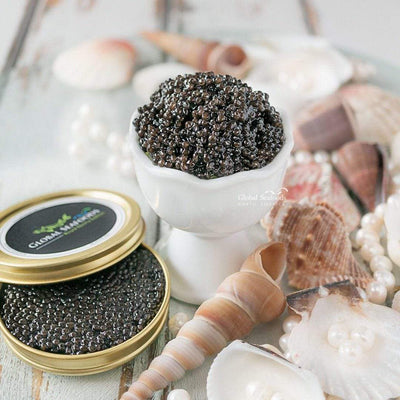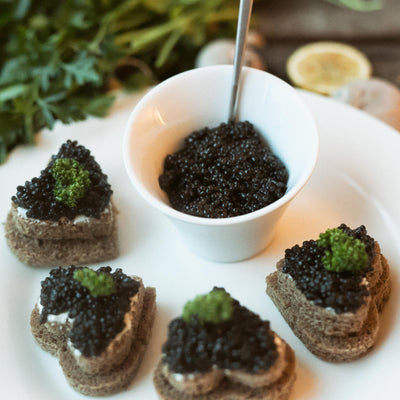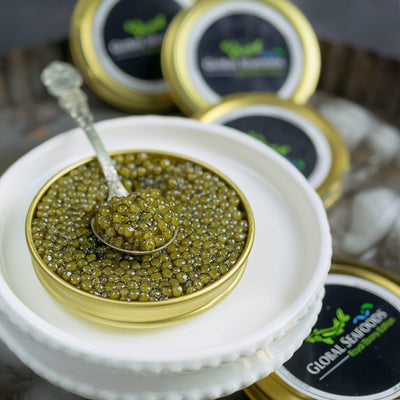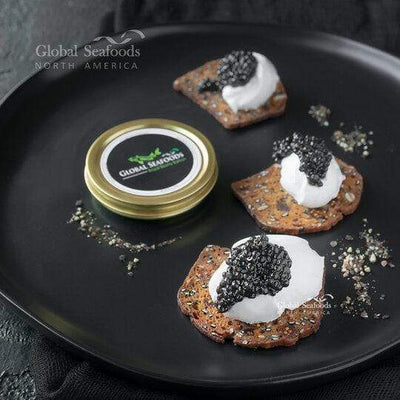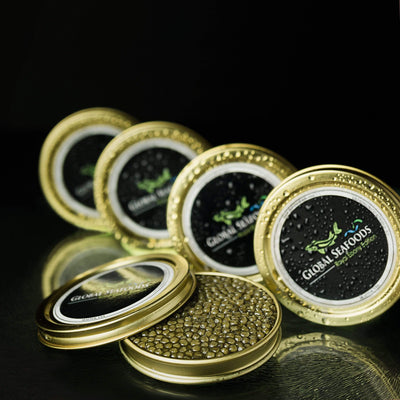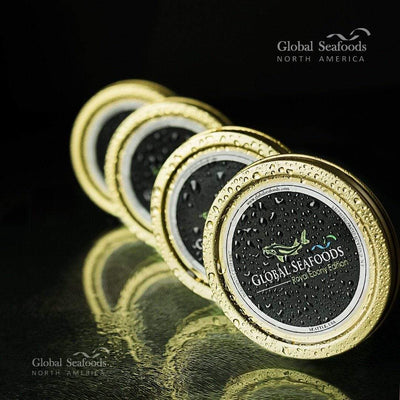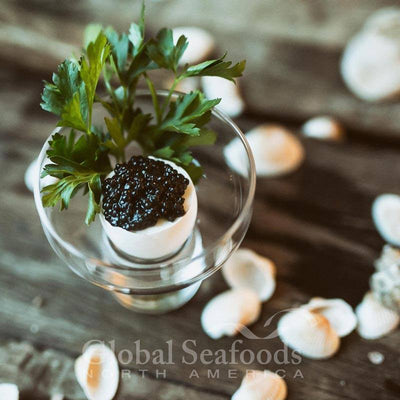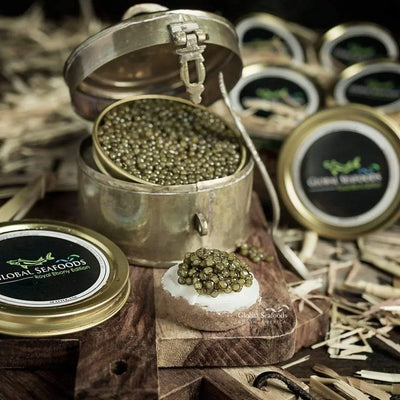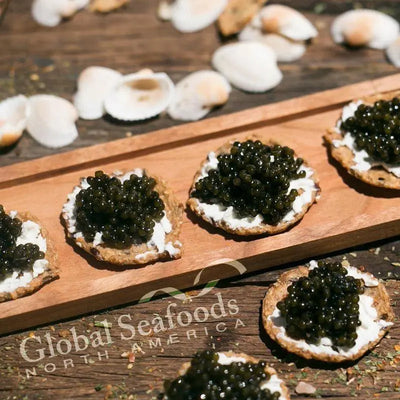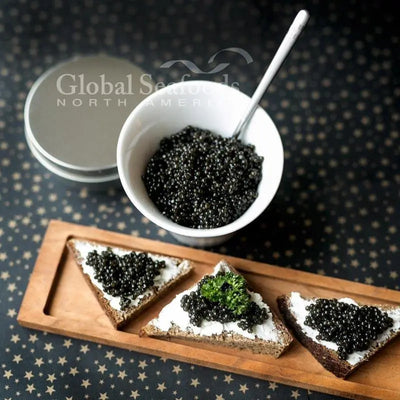The Ultimate Journey Through Osetra Caviar: History, Flavor, and Luxury
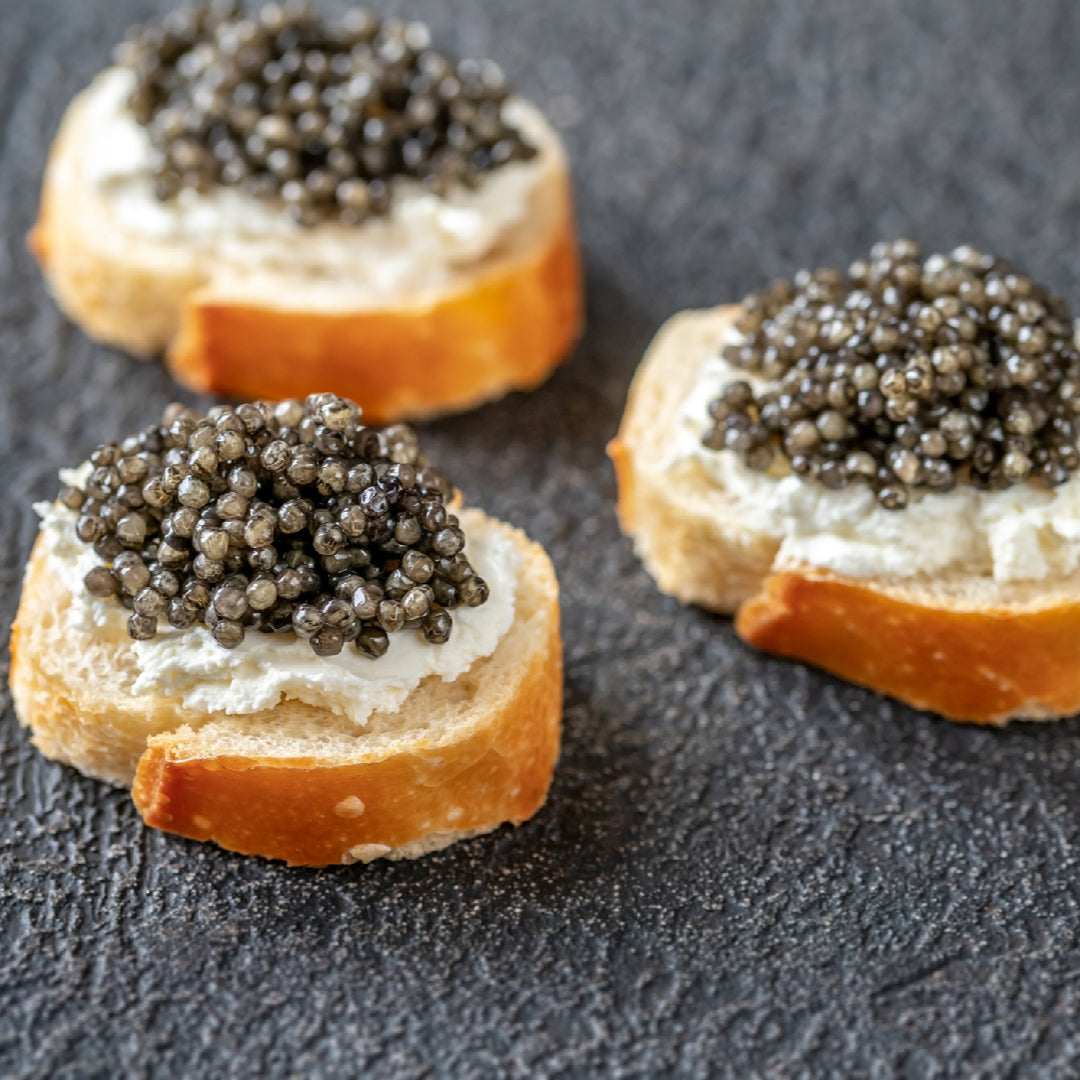
Osetra Caviar: History, Flavor, and Luxury
Osetra caviar, known for its buttery texture and rich, nutty flavor, stands as one of the most prized types of caviar worldwide. This delicacy, sourced from the Osetra sturgeon, has a unique and refined taste that has captivated food enthusiasts and connoisseurs for centuries. As one of the top varieties of black caviar, Osetra caviar embodies luxury, elegance, and an unparalleled experience for the senses.
In this article, we’ll explore the origins, production, flavor profile, and health benefits of Osetra caviar, along with the reasons it has become a sought-after delicacy for gourmets around the globe. For more insight into the world of caviar and fine seafood, don’t miss our YouTube Channel, where we share exclusive insights into gourmet seafood, tasting tips, and recipes.
What Is Osetra Caviar? A Look Into Its Luxurious Origins
Osetra caviar is derived from the Osetra sturgeon, a species native to the Caspian Sea and Black Sea. Historically, the Caspian Sea was home to three major species of sturgeon that produce the world’s finest caviar: Beluga, Sevruga, and Osetra. Among them, Osetra is renowned for its medium-sized eggs, unique golden to dark brown hue, and distinct, nutty flavor. Unlike other types of caviar, Osetra eggs can range in color from deep black to golden yellow, and even light brown.
A History of Prestige and Exclusivity
For centuries, Osetra caviar has been celebrated by royalty, aristocrats, and gourmands. Its delicate production and limited availability have made it a rare luxury, historically reserved for royalty and the world’s elite. As Chef Eric Ripert notes, “Caviar is more than just a delicacy; it’s a cultural symbol of elegance and refinement.”
Quick Fact: In the past, caviar was a staple on the tables of Russian tsars, Persian emperors, and European nobility. The rarity of Osetra sturgeon in the wild contributed to the high demand and exclusivity associated with Osetra caviar.
How Osetra Caviar Is Produced: From Sturgeon to Delicacy
Osetra caviar production is a meticulous and delicate process that requires expert care to ensure the quality and flavor are preserved. Today, sustainable farming methods are widely used to protect wild sturgeon populations and meet the growing global demand for caviar.
-
Sustainable Farming: With wild sturgeon populations under threat, high-quality farms have taken up the task of breeding and harvesting sturgeon in controlled environments. These sustainable practices ensure the preservation of sturgeon species and contribute to high-quality, consistent caviar production.
-
Harvesting: Once the sturgeon reach maturity, skilled artisans carefully extract the eggs, rinsing and salting them in a process called “malossol.” This technique involves using minimal salt to preserve the caviar’s flavor without overwhelming its delicate taste.
-
Grading: Caviar is graded based on size, color, texture, and taste. Osetra caviar is known for its medium-sized pearls with a firm texture and a complex flavor profile that balances saltiness with hints of buttery richness.
Flavor Profile: What Makes Osetra Caviar Unique?
Osetra caviar has a distinct, refined flavor that sets it apart from other types of caviar. Known for its nutty and buttery undertones, Osetra caviar offers a mild yet complex taste, often described as less briny than Sevruga and more robust than Beluga.
- Texture: Osetra pearls are medium-firm, providing a satisfying “pop” when bitten into.
- Color: The color of Osetra caviar can range from deep brown to a rare golden hue, known as “golden Osetra,” which is highly sought after.
- Taste: A unique balance of creamy, nutty flavors with a touch of sea salt, Osetra caviar has a flavor profile that appeals to both beginners and experienced caviar lovers.
Chef’s Insight: “Osetra caviar’s flavor is truly exceptional. The balance of richness and subtle saltiness makes it a culinary experience,” says renowned chef Thomas Keller.
For the best variety of premium Osetra caviar, visit:
How to Serve Osetra Caviar: Pairing and Presentation Tips
The presentation and pairing of Osetra caviar are essential to fully enjoying its unique flavors. Here are some expert tips on how to serve and enhance this delicacy:
1. Serve on a Chilled Plate
To preserve the flavor and texture, Osetra caviar should always be served cold. Use a chilled glass or ceramic dish, and avoid metal utensils, as they can alter the flavor of the caviar.
2. Pair with Simple Accompaniments
Osetra caviar pairs best with classic accompaniments that don’t overwhelm its delicate taste:
- Blini: Thin, soft pancakes that offer a mild base.
- Crème Fraîche: Adds a creamy texture that complements the caviar’s richness.
- Chopped Eggs and Chives: Adds subtle flavor and texture without overpowering the caviar.
3. Drink Pairings for Osetra Caviar
The traditional drink pairing for caviar is champagne or vodka, both of which cleanse the palate and enhance the subtle flavors of the caviar. Alternatively, try pairing Osetra with a crisp white wine or sake for a more delicate pairing.
Sommelier’s Tip: A dry champagne or an unoaked white wine pairs beautifully with Osetra caviar, bringing out its buttery and nutty notes.
For more Osetra caviar pairings, see:
The Health Benefits of Osetra Caviar
Not only is Osetra caviar a culinary luxury, but it is also a nutritional powerhouse. Here are some of the top health benefits:
- Rich in Omega-3 Fatty Acids: These essential fats support heart health, reduce inflammation, and enhance brain function.
- High in Protein: Caviar provides lean protein, which is important for muscle maintenance and immune support.
- Vitamin-Rich: Osetra caviar is high in vitamins A, D, and B12, contributing to immune health, energy production, and bone health.
According to the American Heart Association, omega-3s are essential for heart health, and incorporating them through caviar can be both a delicious and health-conscious choice.
Frequently Asked Questions About Osetra Caviar
Q: What’s the difference between Osetra and other types of caviar?
Osetra caviar is known for its nutty, buttery flavor and medium-firm texture. It falls between the large, delicate Beluga and the smaller, saltier Sevruga caviar in terms of flavor and texture.
Q: Can I freeze Osetra caviar?
Caviar should be kept cold but not frozen, as freezing can alter its texture and flavor. Store it in the coldest part of your refrigerator and consume it within a few days of opening.
Q: What’s the best way to enjoy Osetra caviar?
Osetra caviar is best enjoyed simply, with minimal accompaniments to appreciate its complex flavors. Serving it on blini with a touch of crème fraîche is a classic choice.
Conclusion: The Luxurious Experience of Osetra Caviar
Osetra caviar represents the epitome of luxury dining, offering a rich history, a unique flavor profile, and an indulgent experience for the senses. From the intricate process of harvesting to its distinctive nutty flavor, Osetra caviar is a delicacy that combines culinary sophistication with the health benefits of nutrient-rich seafood. Whether you’re a seasoned caviar lover or exploring it for the first time, Osetra caviar provides an unforgettable experience that embodies true gourmet dining.
For the finest selection of Osetra and other premium caviars, visit Global Seafoods and explore our exclusive varieties:
- Paddlefish Caviar
- Siberian Sturgeon Caviar
- Kaluga Caviar
And don’t forget to check out our YouTube Channel for more on how to savor, serve, and celebrate the world of caviar.
Also in News

Top 10 Geoduck Dishes from Around the World That Will Blow Your Mind
Discover the most delicious geoduck dishes from around the world, from sashimi to ceviche. Learn about geoduck’s taste, texture, sustainability, and where to buy premium live seafood online.

Columbia River Steelhead | Life Cycle, Conservation & Facts
Columbia River steelhead are one of the most resilient salmonid species, embarking on an incredible migration from freshwater to the ocean and back. Learn about their spawning habits, juvenile development, oceanic journey, and conservation efforts. Discover why steelhead are a prized fish for both anglers and seafood lovers.

Mastering Dover Sole: Cooking & Serving Guide for a Gourmet Experience
Dover Sole is a culinary delight known for its mild flavor and tender texture. Whether you're pan-frying for a crispy finish, baking for a healthy meal, or grilling for a smoky touch, this guide provides expert tips on preparing, cooking, and serving Dover Sole. Elevate your seafood dishes and enjoy gourmet flavors at home.

